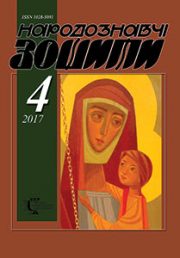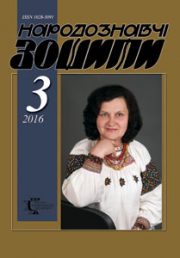The Ethnology Notebooks. 2024. № 2 (182), 247—258
UDK 7.071.1Шевченко-043.3:[378.4:7]-043.86
DOI https://doi.org/10.15407/nz2025.02.247
THE ROLE OF TARAS SHEVCHENKO IN THE SPACE OF UKRAINIAN ART EDUCATION
SHMAGALO Rostyslav
- ORCID ID: https://orcid.org/0000-0002-9853-8989
- Doctor of Art History, Professor,
- Honored Artist of Ukraine,
- Lviv National Academy of Arts,
- Department of History and Theory of Arts,
- 38, Kubiyovycha Str., 79011, Lviv, Ukraine,
- Contacts: e-mail: shmahalo@hotmail.com
Abstract. The activity of T. Shevchenko in the development of art education is considered: little-known facts are analyzed that confirm the documented existence of Taras Shevchenko’s project to create an art school (before the arrest of the artist and poet in 1847). It is stated, in particular, that he gave lectures on the theory of painting and arts, and from February 21, 1847 he was to begin teaching drawing at the Kyiv University named after St. Volodymyr.
The purpose of the study is to substantiate the significance of T. Shevchenko’s creative and teaching activities in the formation of academic art education in Ukraine. The relevance of the topic is due to the fact that it was Shevchenko who became the cornerstone for the formation of the national art school of Ukraine.
Shevchenko’s life goals did not come true, but his ideological and aesthetic worldview had a direct artistic and pedagogical influence on contemporaries and artist-teachers of Ukraine of subsequent generations. With different ideological approaches, Shevchenko’s art education ideas were implemented both in Soviet Ukraine and in the centers of the Ukrainian diaspora. It is proven that in the methodological dimension, Shevchenko’s project had a broad culturological basis, was based on history, archeology, art history, national everyday culture and applied art, and philosophy in general.
Conclusions. Having overcome the stereotypes of academicism, T. Shevchenko established a new creative and pedagogical method, which received many followers and an infinite number of forms of implementation in all types and genres of art.
Keywords: Taras Shevchenko, art education, academy of arts, formation, followers, fine arts, philosophy of art.
Received 21.03.2025
REFERENCES
- (1989). Taras Shevchenko’s story «The Artist». Illustrations, documents. Album. Kyiv: Art [in Russian].
- Ogienko, Ivan (Metropolitan Hilarion), & Tymoshyk, Mykola. (2002). Taras Shevchenko. Kyiv: Our Science and Our Culture [in Ukrainian].
- Zhur, P. (1996). Works and Days of the Kobzar. Lyubertsy: Lyuberetskaya Gazeta [in Russian].
- Shmagalo, R. (2022). Art Education and Art Studies in Ukraine in the Middle of the 19th — Middle of the 20th Centuries: Structuring, Methodology, Artistic Positions. Lviv: LNAM. Retrieved from: https://manusbook.com/9096_Shmagalo_Art_Education/10/index.html [in Ukrainian].
- Central Institute of Art Education of Ukraine in Kyiv. F. 442. Op. 1. Comp. 8241. Ark. 5 [in Ukrainian].
- Zhadko, V. This day in Taras’s fate — December 23! Retrieved from: https://www.facebook.com/share/p/1A4eLH68yC/ [in Ukrainian].
- Shcherbakivskyi, V. Ukrainian art (under the copyright of the manuscript). Central State Archives of Ukraine. F. 3864. Op. 1. File 2. Ark. 51—98 [in Russian].
- Central State Archives of Ukraine in Kyiv. F. 442. Op. 634. File 54 [in Ukrainian].
- Sichinskyi, V. (1951). News from the National Theatre School. Scientific reports. Svoboda, 4 (81) [in Ukrainian].
- (1989). Taras Shevchenko’s story «The Artist». Illustrations, documents. Album. Kyiv: Mystetstvo [in Ukrainian].
- (1976). Shevchenko Dictionary: in 2 vols. (Vol. 1). Kyiv [in Ukrainian].
- (2003). Taras Shevchenko. Letters to various persons. Letter to V. Hryhorovych dated December 28, 1843. Collected works: in 6 vols. (Vol. 6). Kyiv [in Ukrainian].
- (1982). Taras Shevchenko. Documents and materials for biography: 1814—1861. Kyiv: Higher School [in Ukrainian].
- Shevchenko T. (2003). Letters (Vol. X). Chicago [in Ukrainian].
- Shevchenko T. (2003). Letters to Br. Zalessky dated February 10, 1855. Collected works: in 6 vols. (Vol. 6). Kyiv [in Ukrainian].
- Shevchenko T. (2003). Diary. Kyiv [in Ukrainian].
- (1975). Diary of the artist A.N. Mokritsky. Moscow [in Russian].
- Popova, L. (1961). Lev Mikhailovich Zhemchuzhnikov. Kyiv [in Ukrainian].
- Junge, K.F. (1982). Memories of Shevchenko. Memories of Taras Shevchenko. Collection (Pp. 279—283). Kyiv: Dnipro [in Ukrainian].
- Zhadko, V. Kateryna Junge-Tolstaya: «Shevchenko was…». Retrieved from: https://www.facebook.com/share/p/1AVkZwZBfx/ [in Ukrainian].
- Sumtsov, N.F. (1911). Oaks of T.G. Shevchenko. Kharkov [in Ukrainian].
- Gordynskyi, S. (1942). Taras Shevchenko the painter. Krakow [in Ukrainian].
- Arkhipenko, O. (1970, August 13). To my Ukrainian compatriots. Svoboda [in Ukrainian].
- (1953, March 4). Bust of Taras Shevchenko — a new masterpiece by O. Arkhipenko. Svoboda [in Ukrainian].
- Shevchenko, T. (2003). Letter to Br. Zalessky dated 10, 15.02.1857. Taras Shevchenko. Collected Works: in 6 vol. (Vol. 6). Kyiv [in Ukrainian].







